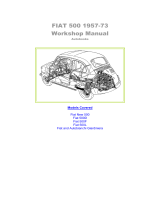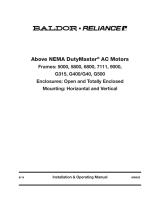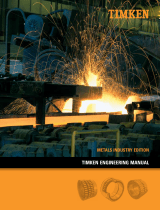Page is loading ...

1
WARNING: All products over 25kg (55 lbs) are noted on the
shipping package. Proper lifting practices are required for
those products.
The DODGE split spherical roller bearing is a unique precision
product. In order to function correctly, it must be properly clamped
on a clean, uniform shaft that is within the specied limits and
adequately lubricated.
Preparation for Mounting
Leave bearing in protective wrapping until ready to assemble it on
the shaft. Do not wash off the preservative coating; it protects the
bearing and is compatible with standard lubricants.
NOTE: Inner and outer ring halves and roller assemblies are
not interchangeable with other bearings. Notice markings on
rings.
1. Remove top half of housing. Scribe mark the cap and
base before removing cap to insure proper positioning
when remounting.
2. Raise shaft. Either raise the shaft uniformly at least 1/32”
or lower the bottom half of the housing by removing shims.
NOTE: Shaft must be firmly supported on each end.
3. Remove old bearing
4. Clean shaft and housing. Shaft surface must be clean
and dry. Remove any raised material or corrosion from
the shaft. Clean housing bearing seat, housing mating
surfaces, and if necessary, the seal grooves. If it is a xed
bearing, check condition of stabilizing ring.
5. Inspect seals. Carefully inspect each seal for wear. If
necessary, remove old seals. Install new split seals after
completion of Step 11.
6. Measure shaft diameter. See Table 1 for correct size,
roundness and taper. If the shaft is not within the specied
limits, it must be reworked.
WARNING: Because of the possible danger to person(s) or
property from accidents which may result from the improper
use of products, it is important that correct procedures be
followed: Products must be used in accordance with the
engineering information specified in the catalog. Proper
installation, maintenance and operation procedures must be
observed. The instructions in the instruction manuals must
be followed. Inspections should be made as necessary to
assure safe operation under prevailing conditions. Proper
guards and other suitable safety devices or procedures as
may be desirable or as may be specified in safety codes
should be provided, and are neither provided by Baldor
Electric nor are the responsibility of Baldor Electric. This unit
and its associated equipment must be installed, adjusted and
maintained by qualified personnel who are familiar with the
construction and operation of all equipment in the system
and the potential hazards involved. When risk to persons
or property may be involved, a holding device must be an
integral part of the driven equipment beyond the speed
reducer output shaft.
DODGE® SPLIT-SPHER™
Roller Bearings and Pillow Blocks
These instructions must be read thoroughly before installation or operation. This instruction manual was accurate at the time of printing.
Please see www.dodge-pt.com for updated instruction manuals.
Table 1 - Recommended Tolerance Range for Shaft Diameters (S1)
Nominal Shaft Diameter
(Inches)
Diameter
Tolerance
(Inches)
Roundness and Taper (Inches)
Over Including
2 4 +0-0.004 0.0007
4 6 +0-0.005 0.0008
6 10 +0-0.006 0.0011
10 14 +0-0.006 0.0011
7. Unpack and disassemble bearing. Unpack bearing and
disassemble it by removing two shoulder screws from outer
ring and four screws (two shoulder and two clamping) from
inner ring.
NOTE: Be sure to remember which side the shoulder
screws came from. They must be replaced in their
original positions.
8. Assemble inner ring halves onto shaft. Position the inner
ring half with the threaded holes on the underside of the
shaft. Prop it up against the shaft by hand (small bearings),
by wooden wedges, or by nylon sling (large bearings).
Position upper inner ring half so that both halves show the
etched number on the same side. Apply light coating of
Loc-Tite to the shoulder and clamping screws and reinsert
into their original positions. Lightly hand tighten both inner
ring halves on the shaft using a metric socket screw key
provided with the bearings. See Figure 2. Using a rubber
or rawhide mallet, tap down the inner ring all around the
outside diameter to ensure complete seating of the ring
halves on the shaft.
NOTE: Do not torque up screws at this time.
9. Insert outer ring half with threaded holes and reposition
inner ring. Place the outer ring half having threaded holes
in the bottom of the housing. For a floating bearing,
center the outer ring between the housing shoulders. For a
fixed bearing, with one stabilizing ring, the outer ring half
should be positioned tightly against the housing shoulder.
Tap the inner ring halves along the shaft until they are
centered over the positioned outer ring. Carefully insert the
lower cage and roller halves between the raceways. If the
cage assembly does not easily t between the lower ring
halves, then tap the inner ring axially to the proper position.
Swivel out the cage assembly, hand pack full of grease,
and reinsert.

2
11. Assemble remaining parts. Place the remaining greased
retainer half on top half of the inner ring. Put on upper half
of outer ring. Be sure the matching numbers and notches
line up.
Position the upper half of the outer ring and tighten the two
shoulder screws by hand. Make sure the outer ring is not
binding on the rollers. Tighten screws with torque wrench
to the values specied in Table 2.
There must be no gap at the split joints of the outer ring.
Again check to be sure the outer ring is not binding on the
rollers. If this is a xed bearing, snake the stabilizing ring
into the pillow block.
If old seals are acceptable, skip to Step 13
.
Figure 3
12. Installation of split seal. Position split seal into lower
housing grooves. Position split at top of shaft. Thread tie-
strap down thru large hole at one end of seal and up thru
small hole on other half. With tie-head seated in the hole,
draw tie across split, thru tie-head and pull tightly (Figure 3)
so seal cannot rotate on shaft. Small gap should be present
at split line once tight. Gap can be xed with sealant to
prevent leakage. Cut excess tie. If possible, rotate shaft
slowly and position seal so it does not rub against housing
grooves. At the same time apply grease to seal grooves.
13. Complete lubrication. Complete greasing of the bearing
and housing as follows: Pack the bearing 100% full. Pack
the lower half of the housing one-half full.
14. Load bearing.
NOTE: Before loading the bearing, rotate the outer ring
split line so that it is 90° away from the load zone. Load
the bearing either by lowering the shaft and bearing
assembly (remove jacks) or by raising the bottom half
of the housing (add shims).
15. Clean and assemble housing cap. Clean the top half of
the housing bore and seal grooves and apply a thin coat of
oil at the split joint. Grease seal grooves. Make sure that
seals are in place on the shaft and place the top half (cap)
of the housing onto the bottom half. Align the scribe marks.
The two dowel pins will align the cap with the base. Caps
and bases of pillow blocks are not interchangeable; each
cap and base must be assembled with its mating part.
Insert cap bolts and tighten cap to base to torque values
in Table 3.
NOTE: For special operating conditions, consult
DODGE engineering.
Table 2 - Recommended Clamping Screw
Tightening Torque
Bearing Bore
(Inches)
Torque
(ft-lbs)
Socket Size
(mm)
Screw Size (mm)
Inner
Ring
Outer
Ring
Inner
Ring
Outer
Ring
Inner
Ring
Outer
Ring
2-3/16 6 1.1 4 2.5 M5 M3
2-7/16 – 2-11/16 6 3 4 3 M5 M4
2-15/16 – 3-3/16 10 6 5 4 M6 M5
3-7/16 10 10 5 5 M6 M6
3-15/16 – 4-15/16 26 10 6 5 M8 M6
5-3/16 – 7-3/16 51 26 8 6 M10 M8
7-½ – 8 88 51 10 8 M12 M10
8-½ – 9 88 26 10 6 M12 M8
9-½ 88 51 10 8 M12 M10
10 88 26 10 6 M12 M8
11 – 13 88 51 10 8 M12 M10
14 212 51 14 8 M16 M10
10. Seat inner ring halves and tighten screws. Using a
rubber or rawhide mallet, tap inner ring halves all around
to insure proper seating as in Step 8. Starting with one
shoulder screw, apply half the recommended torque value
shown in Table 2 to all four screws in the exact sequence
shown below:
1. Shoulder screw.
2. Clamping screw, opposite side.
3. Shoulder screw, diagonally opposite side.
4. Clamping screw, opposite side.
NOTE: This sequence forms a “z” pattern. See Figure 1.
Again tap down the inner ring evenly on the circumference
and tighten all four screws to the full torque, starting with
screw No. 3 and going to No. 4, No. 1 and No. 2. See Figure
1.
Start here
with half
torque
Start
here with
full torque
Top View
Figure 1
A tight t of the inner ring on the shaft is necessary for
satisfactory operation of bearing. There must be a gap on
at least one side of the split joints. The best practice is to
have an approximately equal gap on both sides of the split
joints. See Figure 2.
Small Gap
Figure 2

3
Table 3 - Recommended Torque Values for Cap and Base Bolts (ft-lbs.)
Size Grade 2
Grade 5 Stainless Steel
3/8 -16 16-20 24-30 12-15
7/16 -14 28-32 40-50 21-24
1/2 -13 40-50 60-75 30-38
5/8 -11 80-100 120-150 60-75
3/4 -10 140-175 208-260 105-131
7/8-9 135-170 344-450 101-128
1-8 200-250 512-640 150-188
1-1/8 - 7 280-350 632-790 --
1-1/4 - 7 400-500 896-1120 --
Lubrication
WARNING: Subsequent steps require rotating parts to be
exposed. Stay clear if unit must be running or disconnect
and lockout or tag power source if contact must be made.
Failure to observe these precautions could result in sever
bodily injury.
In order to properly protect bearings after installation, slowly
purge at operating speed until fresh grease appears at both seals.
Select a grease with an operating temperature viscosity which will
provide full lm lubrication (see Table 4). Expect a 20° to 100°F
temperature increase in the bearing. A small amount of grease
at frequent intervals is preferable to a large amount of grease at
infrequent intervals.
Table 4 - Grease Viscosity
DN
(In. ∆ × rpm)
Viscosity for average loads
(SUS @ operating temp.)
100 3500
500 2000
1000 900
2000 400
4000 200
8000 100
∆ Bore diameter
For special applications involving high speeds, high temperatures
or oil lubrication consult DODGE Engineering.
Table 5 - Regreasing Intervals (Months)
(Based on 12 hours per day 150°F max.)
Size
RPM
250 500 750 1000 1250 1500
2-3/16 7 5 3 2 1 1
2-7/16 - 3 6 4 3 2 1 0.5
3-3/16 – 3½ 5 3 2 1 0.5 0.5
3-15/16 – 4½ 4 3 2 1 0.5 0.25
4-15/16 – 5½ 3 2 1 0.5 0.25
5-15/16 – 7 2 1 1 0.5
7-3/16 - 9 1 1 0.5
10 –12 1 0.5

P.O. Box 2400, Fort Smith, AR 72902-2400 U.S.A., Ph: (1) 479.646.4711, Fax (1) 479.648.5792, International Fax (1) 479.648.5895
Dodge Product Support
6040 Ponders Court, Greenville, SC 29615-4617 U.S.A., Ph: (1) 864.297.4800, Fax: (1) 864.281.2433
www.baldor.com
© Baldor Electric Company
MN3017
All Rights Reserved. Printed in USA.
11/14 TCP 15,000
*3017-1114
/




